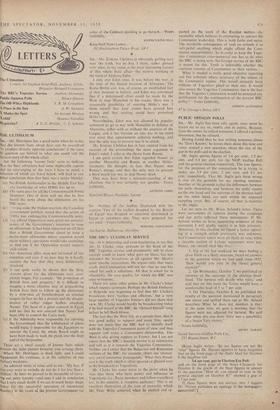PUBLIC OPINION POLLS •
SIR,—Mr. Inglis has been silly again; once more he forces me to say so, rudely and in public. Because, from the outset, he talked nonsense, I offered a private discussion, but he refused.
Haying found that he was writing nonsense,about- the 'Don't Knows,' he leaves them alone this time and raises instead a new question, about the size of the gap in the polls and in the election.
Mr. Inglis quotes figures of 3.6 per cent., 1.5 per cent. and 5.4 per cent, for the NOP, Gallup Poll and the general election respectively. The true figures, for the purposes of the comparison he is trying to make, are 3.9 per cent., 2 per cent. and 4.3 per cent. respectively. That Mr. Inglis gets them wrong is one of the grounds for my opening sentence. Another of the grounds is that the.differences between the polls themselves, and between the polls' results. on the one hand and the outcome of the election itself on the other hand, are well within the expected sampling error. But, of course, all that is, statistics to Mr. Inglis.
Let me turn to . Mr. Brian Acland's. letter. There. were movements of opinion during the campaign and our polls reflected these movements. If Mr.. Aeland wishes to have supporting evidence of this statement I will gladly supply: it to him privately. Moreover, in this election, we fOund a factor operat- ing at a strength which previously was unknown, that' Conservative voters were all likely to vote, while a sizeable section of Labour supporters were not.. Hence, our record read like this: 1. Up to the last weekend we were finding a close finish as a likely outcome, based on answers to the question which we had used since 1955, 'How '. would you vote in the (next) general election'?'
2. On Wednesday, October 7, we published an estimate of the outcome or the election head- lined, 'the turnout will decide who rules,' and said that on this basis the Tories would have a comfortable 'lead of 5 to 7 per cent.
3. On Thursday, October 8, we published the .- results- of the question mentioned in paragraph one above and spelled them out as Mr. Acland describes. What he does not mention is that, at the same time, we gave a warning that the figures were not adjusted for turnout. We said that when this was done there was a possibility of a 'major Tory victory.'
—Yours faithfully, Social Surveys (Gallup Poll) Ltd., 211 Regent Street, WI HENRY DURANT
[Brian Inglis writes: 'So my figures are not the "true" figures. Dr. Durant appears to have forgotten that on the front page of the Daily Mail for October 8 the headline ran
3.6 per cent, gap in Election Eve Poll
and on the front page of the. News Chronicle for October 8. the granh of the final figures in answer to the question 'How do you intend to vote in the general election on October 8'?" showed , a gap of 1.5 per cent.
'If these figures were not correct, may I suggest Dr. Durant publishes an apology in the newspapers concerned'?']










































 Previous page
Previous page